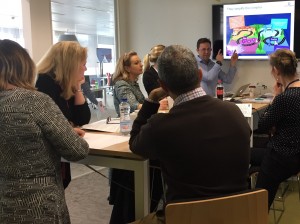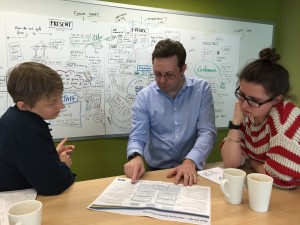
 Too often the language is ‘programme speak’ and full of jargon.
Too often the language is ‘programme speak’ and full of jargon.
Process is the focus of communication not the impact or outcome – so audiences see the HOW but not the WHY.
Progress is described in milestones or stage gates.
And behaviour changes are practically ordered of an audience.
To break this inevitable cycle for an insurance company we recently ran a workshop with their change team in their brand new call centre; the challenge was to equip the team to pitch their programme.
This seemed simple enough but the programme had been running for over a year, and its reputation wasn’t great, plus the changes were quite complex, and far from interesting.
So what did we do?
We brought together eight programme team members, two artists and a couple of communicators.
We shut down our laptops, put away all the gantt charts and banned Powerpoint in any form for the day.
Then we talked…
 During this time our artists sketched the key points and we captured the language used – after a short while they started talking in metaphors, and using analogies from normal every day life – in other words they started describing the programme in plain English. The jargon vaporised and the passion returned to their voices.
During this time our artists sketched the key points and we captured the language used – after a short while they started talking in metaphors, and using analogies from normal every day life – in other words they started describing the programme in plain English. The jargon vaporised and the passion returned to their voices.
Then over a few hours we worked with the artists to paint a picture of the past – before the programme was set up, present – how the programme formed and what it is achieving today, and the future – what the business will look like and the positive impact the change will have on colleagues, customers and suppliers.
We also developed a set of sticky speaker notes to accompany the visual so that any one of the team could repeat it with confidence.
After a bit of tweaking, and lots of peeking from curious colleagues passing the meeting room, we had a 12 foot visual that revealed a simple, clean and colourful change journey. And of course the visual and script focused on people – what was needed from them, and what impact their support would have on the business and customers.
They say a picture paints a thousand words, and in our case that’s true, after we gave a quick demonstration the team were able to tell the full programme story in a couple of minutes using just a handful of prompts.
Even our artists, with no prior knowledge of the programme, could explain the narrative to passers-by.
So what are my personal highlights of day?
Seeing happy clients and those light-bulb moments when suddenly the complex road ahead is less intimidating, the hard work and preparation that goes into these sessions makes it all worthwhile.
The visuals have since been used for induction programmes and refresher training for colleagues. And the process has been replicated in a number of forms, and a number of projects already.
Was this article useful? Do you have a burning question about communication and how to engage your audience? Drop us a line, we’d love to hear from you.